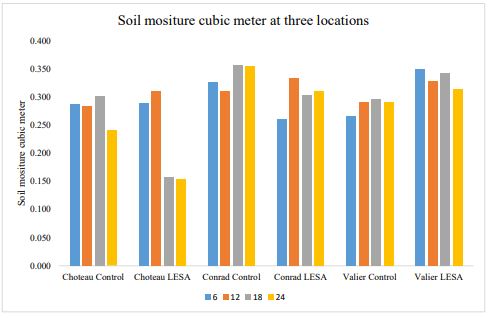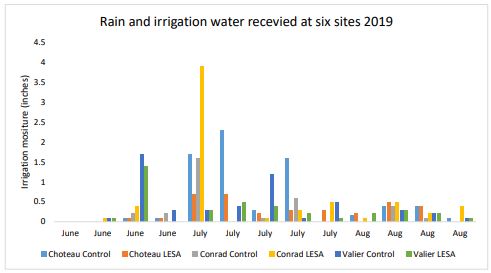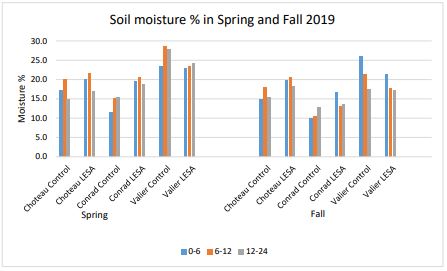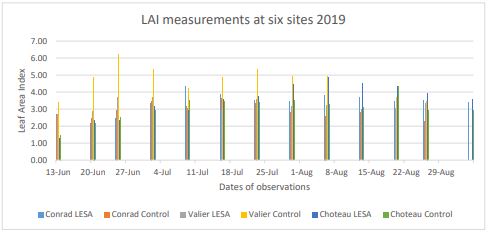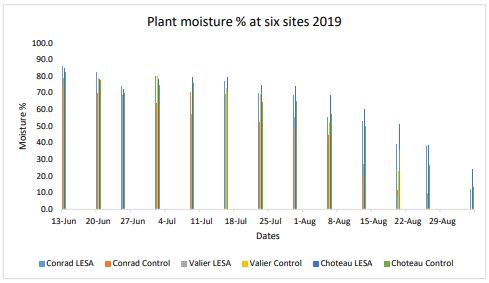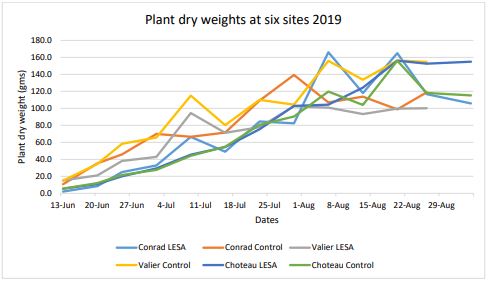Low Energy Sprinkler Application Effect on Montana Malt Barley
Personnel:
Dr. Gadi VP Reddy, Research Leader USDA-ARS-Southern Insect Management Research Unit, Stoneville, MS 38776, USA (relocated since September 2019).
John Miller, Research Scientist, Western Triangle Agricultural Research Center, Montana State University (retired in October 2019).
Alysha Miller, Field Technician, Western Triangle Agricultural Research Center, Montana State University.
Dr. Anamika Sharma, Post-doctoral Research Associate, Western Triangle Agricultural Research Center, Montana State University (joined in September 2019).
Background
Barley has been grown in North America over the years as a forage crop, feed crop and malt crop adapting to dry land and irrigated ecosystems, and it works well in rotation with sugar beets serving as a valuable source of malt in Montana. In spite of vast variation in response of barley varieties to soil types, rainfall, nutrient content and other environmental factors, Montana is second in barley production, producing 22% of the U.S. barley, with an average yield of 60 bu/ac. (USDA, 2015). Providing water requirements by choosing acceptable irrigation methods to have the proper moisture distribution, leads to maximized grain yield, malt quality and decreases weed growth and disease. Depending on the irrigation method, optimum yield that might be expected to happen when available soil moisture (ASM) is to retain above 50% of ASM. The center pivot system is a dominant irrigation method in Montana barley fields, and was designed to conserve water. The pivot should be correctly installed and managed to achieve high water conservation. It has been reported that a pivot system is the most common irrigation method in Montana, and applies water in a uniform distribution and efficient manner, but is not the best method to keep the soil moisture at proper levels during the barley reproductive period (Rogers et al., 2008).
Water limitation or inappropriate distribution leads to abundant morpho-physiological and biochemical changes in plants. There are not too many studies on plant physiology responses to using different irrigation methods in terms of seed quality, yield and water conservation. Therefore, the present study aims to investigate on:
-
Compare Low Energy Sprinkler Application (LESA) irrigation system with regular or traditional irrigation methods in selected barley fields.
-
Study the effect of irrigation methods on dry matter pattern and leaf area during the season.
-
Compare the differences in yield components, plant height and physiological traits related to yield under different irrigation application methods.
Material and methods
Locations and Installment
In order to test LESA methods and compare their effect on malt barley in Montana, experiments were conducted at six sites in three different locations (2 sites at each location), Choteau, Conrad, and Valier. At these sites phenological events, agronomic traits and physiological responses under center pivot system with a single drop tube (Regular, hereafter identified as ‘Control’) and the 2- drop tubes sprinklers (hereafter LESA site) for LESA pressure reducers and spreader plates. For installing the two drop tubes the multiple drop tubes were split off the single outlet to create two drop tubes. In comparison to last year (in 2018 control, two drops, and three drops were compared), this year at the LESA site, the entire pivot was set up as 2 drop system.
One data loggers, four soil moisture sensors, and a manual rain gauge were installed at each site in Choteau, Conrad, and Valier locations. The soil moisture sensors were installed at four depths including, 24 inches, 18 inches, 12 inches and 6 inches below the soil surface after planting and removed from the fields when the plots were harvested. Soil moisture probes and data loggers were installed soon after seeding as practical, they were installed at the two sites at Choteau on May 31 and June 11, two sites at Conrad on May 23, 2019, two sites at Valier on May 30, 2019. Soil moisture samples were taken two times during the entire experiment, the first set of samples was taken while installing the moisture probes and the second set of soil samples were produced after harvesting. Soil samples were broken into six-inch increments for all depths. Water usage was measured throughout the cropping season to see if there is a difference in efficiency between the irrigation methods.
Seeds were planted on two sites at three locations on different dates, varied seeding rates and with variation in fertilizers as explained in Table 1.
Table 1: Seeding dates, crop varieties, seeding rates, and fertilizers at three locations in 2019.
|
Location |
Control |
LESA |
|
Choteau |
May 2, 2019 (Merit 57 barley); 100 lb/ac; top dressed 12 tons manure/ac |
May 10, 2019 (Merit 57 barley); 100 lb/ac; top dressed 12 tons manure/ac |
|
Conrad |
September 15, 2018 (Keldin winter wheat) |
May 15, 2019 (Voyager barley) |
|
Valier |
May 1, 2019 (Coors barley) |
May 1, 2019 (Coors barley) |
Data Collection
Plant sampling plots were along both sides of field transects in parallel with installed soil sensors. Plot size was measured at 5 ft x 20 ft. Row spacing was considered about 7.5 inches.
For measuring leaf area index (LAI C2200) was used to record plants leaf area weekly between the tillering and physiological maturity stages, during 9 a.m. to 3 p.m. Every week plant samples were cut at ground level, oven-dried at 70˚C for 72 hours to reach a constant weight and subsequent data was recorded. Biomass dry weight was also recorded. Every week plant height was measured using a ruler, depth of soil moisture using the brown probe was measured, and rain gauges were also checked and reset weekly.
A Wintersteiger Classic plot combine was used to collect harvest data for each sampling block along the transect. As post-harvest data, grain yield, test weight, seed protein, plump and thin kernels were collected. Kernel plumpness was assessed by sieving over a 6/64” slotted screen. Grain protein content and test weight were obtained at Western Triangle Agricultural Research Center, Conrad using the Near-Infrared Inframatic 9500 SW- Whole Grain Analyzer (Perten Instruments IM9500; Hägersten, Sweden).
Statistical Analysis
Data were processed for ANOVA in Microsoft Excel (2016). Means within the groups were obtained from ANOVA were used to analyze the Least Significant Differences by using the graphing calculator (TI-nspire CX II, CAS, Texas Instruments, Dallas, Texas, U.S.). Graphs were generated in Microsoft Excel (2016).
Results
Soil type at six sites varied and overall moisture percentage also varied. Out of six sites, five sites had barley grown, whereas the control site at Conrad had winter wheat. Therefore yields at Conrad are not compared however they are analyzed separately (Table 2). At Choteau, LESA site had numerically higher yields compared to the control site however there was no statistically significant difference. Whereas at Valier, control site had greater yield compared to the Valier LESA site, but there was no significant difference. At both Choteau and Valier locations, at control sites higher test weight, plant height, and plumps recorded but both control sites had less protein compared to LESA sites (Table 2). The LESA site at Valier also had a patch of weeds that might have contributed to the low yields.
In terms of soil moisture recorded by ground soil sensors indicated greater soil moisture (cubic meter) at Valier LESA site at all four depths (6, 12, 18, and 24 inches). Whereas at Choteau and Conrad locations only at 12 inches, the LESA site showed greater moisture (Figure 1). Rainfall and irrigation water received at six sites also varied (Figure 2). The maximum amount of water was collected in July at all the locations and especially at the LESA site of Conrad (3.9 inches). A sudden increase in water collected in rain gauge at Conrad location could also be because of rainstorm encountered in this area in July 2019.
Soil moisture obtained by comparing dry and wet soil samples in spring (May) and fall (August) of 2019, indicated the use of water content from the soil during the crop production. Soil moisture at the soil depth of 6-12 inches indicated drop at all the six sites. Soil moisture at the depth of 0-6 inches also showed decrement at all the sites, other than the Valier control site (Figure 3). Also to indicate that Valier control had the maximum yield (Table 2).
In terms of performance of crop, LAI and plant matter was analyzed. Although no significant variations were observed in LAI, numerically greater LAI was measured for the Valier control site. Valier control site overall (June-August) had greater LAI measurement, followed by Choteau LESA>Conrad LESA. At two locations (Choteau and Conrad) greater LAI were obtained for LESA sites, whereas at Valier location it was reversed (Figure 4). In general the greater the LAI is an indication of higher yields, which is also shown in present data where maximum yield was recorded at Valier control. Average plant moisture was overall greater for Choteau LESA site, followed by Conrad LESA=Choteau control>Valier control>Valier LESA>Conrad control (Figure 5). Plant dry matter accumulation increased by leaf number and tiller development until anthesis and then started to decline as the plant began to ripen, with a noted increase just before harvest at Valier Control (Figure 6).
Overall results indicate although not a significant but numerically greater moisture content, plant dry matter, and LAI were observed at LESA sites. In Valier, the control site performed better in terms of yield, which is supported by other datasets including plant moisture, soil moisture, and LAI measurements. Nevertheless, some impact of the presence of weeds at Valier LESA might also have played role in lowering the parameters at Valier LESA site. None of the sites had any significant effect on plant height, plumpness and thin. Greater protein content was generated at LESA sites. Also since Conrad control was winter wheat field we did not compare the yield data for Conrad location.
Recommendations
Sprinkler height affects the wetted area, water distribution and water productivity especially in windy areas like Montana’s Western Golden Triangle region. Wind velocity also influenced water distribution and uniformity, once released from sprinkler irrigation systems. In the present study for most of the parameters, there was no significant difference in using the regular center pivot system and LESA application. Even though there are no significant differences in the grain data it appears that the LESA irrigation system has an impact on soil moistures and plant performance in terms of dry matter, LAI measurements. Chances of disease occurrence are there with greater moisture with LESA application however, no disease occurrence was observed at six sites in 2019. Nozzle size, height and drop numbers to meet plant water requirements might increase regular pivot system efficiency. Testing different varieties of barley, various crops, using precision application based on crop needs and soil profile in consecutive multi-location experiments would deliver scientists and farmers a better understanding of water- plant -soil relationships. Also, assessing the effect of different water regimes on saved water amount and plant response would be useful.
Acknowledgments
We are grateful to In-Bev, Anheuser-BuschAg Company for financial and technical support during the experimental period. In addition, we appreciate Mr. Joe Campbell, Mr. Greg Orcutt and Mr. Ken Wheeler as experiment collaborators in Choteau, Conrad and Valier. A special thanks goes to summer intern Hayley Reis who helped in collecting data in 2019.
References
Espinoza, B., J. C. E. P. Velez, J. C. Morales and B. R. Martinez. 2004. Impact of pressurized irrigation systems performance on productivity of eight crops, in Guanajuato, Mexico. Agrociencia-Montecillo 38(5): 477-486.
Rogers, D.H., M. Alam, and L.K. Shaw. 2008. Considerations for Sprinkler Packages on Center Pivots. Kansas State, Research and Extension. Irrigation Management Series. L-908 rev.
USDA. 2015. United State Department of Agriculture, Natural Agricultural Statistic Service, Montana Annual Crop Summary 2014.
Table 2. 2019 LESA irrigation, grain data by location. Data were processed for ANOVA in Microsoft Excel (2016). Means within the groups were obtained from ANOVA were used to analyzed the Least Significant Differences by using graphing calculator (TI-nspire CX II, CAS, Texas Instruments, Dallas, Texas, U.S.).
|
Location |
Irrigation |
Yield |
Test Wt |
Height |
Plump |
Thin |
Protien |
|
|
Type |
(bu/ac*) |
(lb/bu*) |
(inch) |
(%) |
(%) |
(%) |
|
|
|
|
|
|
|
|
|
|
Conrad |
LESA |
148.4 |
53.1 |
32.5 |
99.1 |
0.4 |
8.98 |
|
|
Control** |
133.7 |
61.3 |
31.5 |
NA |
NA |
11.42 |
|
Mean |
|
NA |
NA |
NA |
NA |
NA |
NA |
|
LSD |
|
NA |
NA |
NA |
NA |
NA |
NA |
|
C.V. (s/mean)*100 |
|
NA |
NA |
NA |
NA |
NA |
NA |
|
P- Value |
|
NA |
NA |
NA |
NA |
NA |
NA |
|
|
|
|
|
|
|
|
|
|
Valier |
LESA |
149.6 |
52.6 |
25.8 |
95.2 |
1.7 |
11.12 |
|
|
Control |
200.9 |
55.7 |
29.5 |
98.9 |
0.4 |
10.58 |
|
Mean |
|
175.3 |
54.2 |
27.6 |
97.0 |
1.0 |
10.85 |
|
LSD |
|
ns |
0.705 |
0.935 |
2.267 |
0.353 |
ns |
|
C.V. (s/mean)*100 |
|
32.9 |
3.15 |
7.48 |
2.43 |
72.77 |
6.86 |
|
P- Value |
|
0.2332 |
0.00004 |
0.00006 |
0.0065 |
0.000085 |
0.3421 |
|
|
|
|
|
|
|
|
|
|
Choteau |
LESA |
182.4 |
52.2 |
35.5 |
91.9 |
3.2 |
10.67 |
|
|
Control |
168.0 |
53.0 |
36.5 |
95.7 |
1.5 |
8.71 |
|
Mean |
|
175.2 |
52.6 |
36.0 |
93.8 |
2.4 |
9.69 |
|
LSD |
|
ns |
ns |
0.998 |
3.193 |
ns |
1.571 |
|
C.V. (s/mean)*100 |
|
9.5 |
1.54 |
2.10 |
2.84 |
60.00 |
13.87 |
|
P- Value |
|
0.2489 |
0.2021 |
0.0498 |
0.0262 |
0.0890 |
0.0225 |
* Yield and test weight are adjusted to 13% seed moisture.
** Conrad Control is winter wheat, hence means are not obtained and compared. NA=not applicable since no plumps and thins were obtained from winter wheat crop
Figure 1: Soil moisture (cubic meter) recorded for three locations (Choteau, Conrad,
and Valier)
at six sites (3 control sites and 3 LESA sites) with moisture sensors.
Figure 2: Water received (rainfall and irrigation) in three locations (Choteau, Conrad,
and Valier)
at six sites (3 control sites and 3 LESA sites) measured with rain gauge.
Figure 3: Soil moisture (%) measured at three locations (Choteau, Conrad, and Valier)
at six sites
(3 control sites and 3 LESA sites) at the time of installation (spring) and harvesting
(fall) at three
depths (0-6, 6-12, 12-24 inches).
Figure 4: Leaf Area Index (LAI) measured at three locations (Choteau, Conrad, and
Valier) at six
sites (3 control sites and 3 LESA sites) from June to August 2019.
Figure 5: Plant moisture percentage measured from June 2019 to August 2019 for barley
and
winter wheat at three locations (Choteau, Conrad, and Valier) at six sites (3 control
sites and 3
LESA sites).
Figure 6: Plant dry weight measured for barley and winter wheat from June to August
2019 at
three locations (Choteau, Conrad, and Valier) at six sites (3 control sites and 3
LESA sites).

